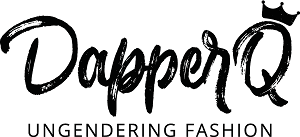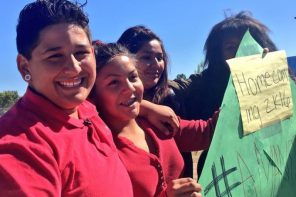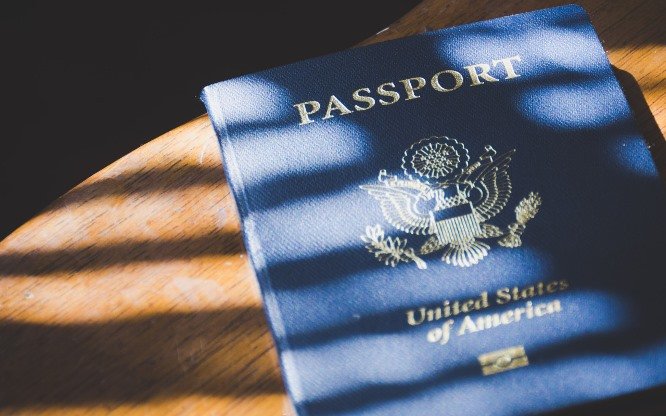DapperQ’s Transgressor-in-Chief Susan Herr once stated “the words ‘dyke’ and ‘fashion’ don’t usually go together. Gay boys get the glory — lesbians, not so much.” So, for this month’s “Pride” installment of He Said/We Said, I wanted our models to interpret an outfit by a masculine-of-center fashion designer who has a household name and as much international clout as superstar gay fashion designers Christian Dior, Dolce and Gabanna, John Bartlett, and Perry Ellis.
My hunt to find such a designer was a fruitless effort (although, I am excited about Marimacho’s potential to become a household name). Instead, my search yielded countless articles tying our community to anti-fashion and anti-consumerism movements, both of which have been very important to the “good fight,” but provide little inspiration and advice to those who want to fight the “good fight” fashionably. I was also not hard pressed to find an abundance of mainstream media mocking genderbending fashion.
dapperQs are not seeking fashion approval from hetero-normative media. Rather, dapperQs want to change the fact that fashion media tends to be hetero-normative.
Genderbenders are increasingly replacing all-out anti-fashion philosophies with a fashionable form of protest: using fashion as a site of resistance, to show pride, and to challenge mainstream media’s portrayal of women as passive bodies for male consumption. For a growing number of dapperQs, being fashionable and fighting against the machine are no longer mutually exclusive.
Using fashion as a vehicle for in-your-face resistance, dapperQs are able to say to the world that they can be downright sexy without being objects. They can fearlessly match their outward appearances with their inner selves, and not feel as if they are abandoning their principles if they choose to do so with style.
I asked some dapperQs to share with me how they express pride through fashion, and here’s what they had to say:
“I am proud of where I come from. I feel connected to the land and music of West Virginia; it’s a large part of my truth. I have an extensive vintage country music t-shirt collection that ranges from Loretta Lynn’s very first Coal Miners Daughter tour to the Judds and Waylon Jennings. When I need to dress up, I like to add gingham when I can and I wear square-toe harness Frye boots with everything. I am not afraid to wear a Brooks Brothers tailored three piece suit with a gingham bow tie; it’s actually a preference. I have a lot of fun accessorizing with vintage glasses and belt buckles too. “
– Gina Mamone, President & CEO Riot Grrrl Ink., Largest Queer Record Label in the World — pictured wearing red gingham. Photo by Maro Hagopian who shot this month’s Pride installment of He Said/We Said
“I express my pride through fashion, by loving myself and wearing things that make me feel comfortable in my skin and good about myself. I can’t generalize my style, but I can say that I love feeling good in my clothes and having pride in who I am.”
– Kit Yan, 26, Performance Poet
“I express pride by unapologetically wearing masculine clothing. When I wear masculine clothing, particularly in spaces that are not necessarily queer, it helps to carve out space for gender-queerness. In that way, fashion can be a powerful way to increase queer visibility.”
– Crystal González, 23, Co-owner of masculine-of-center clothing line Marimacho
“For me, fashion is a direct reflection of my identity. It’s a chance for me to be uniquely ‘me’ in a world that doesn’t allow for much variation in so many other ways. So, in doing just that – finding the combinations that articulate who I am – is expressing my pride.”
– Jama Shelton, 36, Professor and Social Worker
“Fashion is a fundamental way in which I express pride. I am a weird creature that most people don’t know what to do with – a masculine-presenting queer, a fat person, an enigma. I dress like I do because I feel that my body matters – the way I take space matters – and that it is a fundamental act of pride to insist that I can be the things I am and look AWESOME. I like that I am, through my fashion, a brave and visible queer. There is nothing more exciting to me than the idea that I might, through my visibility and bravery, inspire someone else to take their own risks in becoming themselves.”
– Ariel Speedwagon, 28, Performer/Master of Ceremonies
“Pride through fashion- the funny thing is, fashion for me has been pretty much the opposite of pride for most of my life. In fact, it’s been little more than the brass knuckles on the fist of American Expectation which punches me in the gut daily. My outfits of choice – baseball hats, baggie jeans, sneakers, T-shirts in dark colors- these ordinary, boy-next-door choices, are somehow subversive to the world at large. Living in one of the most ‘open’ cities in the country, I am still affronted by cold, lingering stares inspired by fear, confusion, and doubt. ‘He? She? What is on its head? Is that a baseball hat? Is it a boy? But it has breasts? But it’s wearing a hat?’ This is how most people seem to think, and it’s why I’ve come to be involved with dapperQ. Because I want it to change. Because for a select few, my clothes are a sign that I will not change; I will not budge. I will be who I am, wear what inspires me, and screw the rest of you, because clothes do not make the person. So this is when I have pride: when I see a fellow person, a fellow dapperQ, who also believes that people are more important than the clothes. And that the clothes are just a tool to learn, to teach, and to discuss. This is why we need dapperQ: for our pride to become all humans’ pride.”
– Dana Variano, 27, dapperQ Creative Director, Film Maker, Founder of Where’s My Sled? Productions
“All of us have an external appearance that is an undeniable part of our being, which is why I take pride in my physical presentation – because I am proud of my whole package. People should not feel as if they cannot take pride in looking amazing simply because of their gender presentation. And it’s pretty awesome to be able to use fashion as another method of expressing your personality, and in my case, giving myself an opportunity to venture outside of the confines of my shyness. As a component of my whole package, I hope that my fashion/outside appearance relays a message of a person who is out and proud, as I am through my politics and activism.”
– Senka Filipovic, 30, Consultant, Bronx Community Pride Center Young Leaders Council Member
“I express ‘pride’ through fashion simply by being myself. It isn’t easy to face the world as a gender-role nonconformist. I can’t ‘pass’ or blend-in. Stepping out in style further highlights my uniqueness for all to see. I’m proud of who I am: A dapper, young professional lesbian.”
– Tiffany Baily, Photographer
And with that, I dedicate the Pride installment of He Said/We Said to our fashion maveriQs. Tune in this week to see our He Said/We Said models interpreting a look by Marc Jacobs!





This really helped me feel a bit stronger today, thanks so much 🙂
My fashion style has been boring lately…thanks for the inspiration to kick it up a notch.
Great job!!!! Here’s to keeping it real and being yourself.
Huummm, where have you been all of these years. I’ve been sporting this look for a very long time, good that you are finally catching up.
Now, Lets Get Dressed Up!